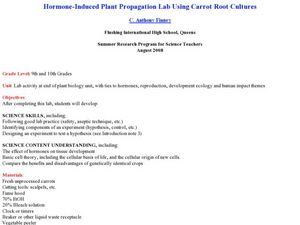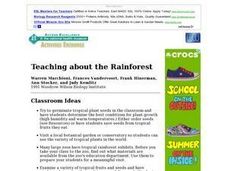Curated OER
Extraction of Caffeine from Tea Leaves
Students conduct an experiment in which they extract the greatest number of grams of caffeine from four bags of tea. They conduct Internet research, conduct the experiment, and record their observations and data.
Curated OER
Drug Analysis Using Thin-Layer Chromatography
Students use forensic science to positively identify any suspected drugs submitted to the laboratory. They determine the identity of the drugs found in the bodies of drug-overdose victims. Students use TLC to identify the active...
Curated OER
Holy Starbucks Batman
Students investigate caffeine as a potential new pollutant in a northwest river system. Effects of caffeine on invertebrates and salmon fry will be explored through field work and lab work.
Curated OER
Fishy Behavior
Here's a lab that may make you rethink that morning cup of coffee. Biology scholars test the effects of caffeine, alcohol, and nicotine on the behavior of zebrafish through an intriguing experiment. Learners observe fish...
Curated OER
Alcohol, Nicotine or Caffeine Rap
Students create a rap/skit showing the effect of alcohol, nicotine or caffeine. In this biology lesson, students identify the important points of their chosen drug. They present their rap/skit in class.
Concord Consortium
Acid Test
This isn't your typical basic lesson—it's more acidic! Learners use pH information to determine the hydroxide ion concentration of different substances and then use these values to analyze information. The calculations require...
Curated OER
Hand Lotion Analysis
Students prepare a sample of a commercial hand lotion for analysis by HPLC to determine the percent composition of two common cosmetic preservatives, methylparaben and propylparaben. They perform the analysis and the data is evaluated to...
Curated OER
Growing Barley for Use in Biosynthesis Experiments
Students attempt to determine the optimum growing conditions for barley. They assess the effects of a number of substances such as ammonium chloride and urea on the plants
Curated OER
Explorit's Coffee, Tea or Chocolate Quiz
In this coffee and tea worksheet, students complete a six question multiple choice on-line interactive quiz about the cultivation and chemistry of coffee, tea and chocolate.
Curated OER
Embryological Development Using Medaka Fish
High schoolers analyze and record major events that occur in the development of Medaka fish eggs from fertilization to hatching. In small group, students describe the processes involved, creating a timeline of the major events in the...
Curated OER
Practice Sheet: Colligative Properties
In this colligative properties worksheet, students solve eight problems. They calculate molarity, molality and grams of substances in addition to using colligative properties to calculate solutions.
Curated OER
The Effects of "Recreational" Drugs on the Development of Chick Embryos as a Model for Human Embryogenesis
Students conduct experiments on fertilized chicken embryos to determine the possible developmental effects that various recreational drugs (caffeine, alcohol, nicotine, and aspirin) might have on them.
Curated OER
Finding Concentration
In this determining concentration activity, students are given the equations to find the concentration of a solution in grams per milliliter, to determine the concentration in parts per million, to determine percent mass and percent...
Open Colleges
Your Brain Map: Strategies for Accelerated Learning
The brain is a complex organ with many different structures and functions. An interactive diagram allows learners to explore the different structures while pop-ups describe their functions. Secondary interactives show the structures of...
Curated OER
Hormone-Induced Plant Propagation Lab using Carrot Root Cultures
Learners evaluate the importance of hormones in living things. For this biology lesson, students experiment on carrots to differentiate how humans and plants reproduce. They collect data from experiment to answer analysis questions.
Curated OER
The Portion is the Poison
Students calculate the amount of everyday food products or liquids that would need to be consumed in order to become toxic. By using unit analysis, they calculate the amount of certain common food items that would need to be consumed in...
Curated OER
The Perils of Drinking Water
Students determine the presence of drugs in water. In this chemistry instructional activity, students experiment on water samples using thin layer and column chromatography. They determine the concentration of drugs present using...
Curated OER
The Young Virginia Gardener: Container Gardening-The Old English Tea Garden
In this gardening worksheet, students read about the custom of tea drinking and how to brew tea using herbs grown in a container garden. Students answer 2 related questions.
Curated OER
Toxicants and California Blackworms
Students determine the normal behavior of California blackworms. They determine how various concentrations of assigned toxicants affect the worm's behavior. Students are introduced to testing of potential toxicants, an important...
Curated OER
Teaching about the Rainforest - Classroom Ideas
Students are introduced to the tropical rainforest through different ways that catch their attention such as: Visit a local botanical garden or conservatory so that students can see the variety of tropical plants in the world. They...
Curated OER
Environmental Hazards
Students identify environmental hazards on a simulated field trip. They analyze the exposure and suggest methods to eliminate or reduce exposure to toxic sources.
Curated OER
Aspects of Individual Human Blood Pressure
Students learn about human blood pressure. In this biology lesson plan, students gain an understanding of the relationship between hypertension and it's risk factors, demonstrate how pressure builds up in clogged arteries, and measure...
Curated OER
Related to Natural Products
High schoolers examine how the microwave delivers energy at different power levels. They work together to complete experiments on various materials and different power levels. They answer discussion questions to end the lesson.
Curated OER
How Organisms Respond to Changes in their Environment
Students observe the reaction of living cells to mechanical and chemical stimuli by introducing different stimuli to an organism under a microscope and recording the response.























